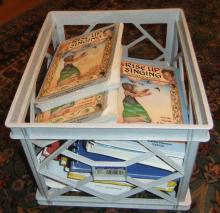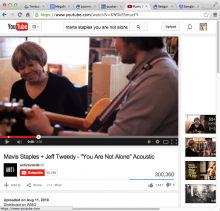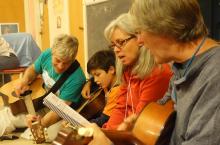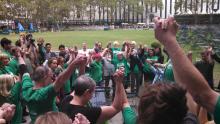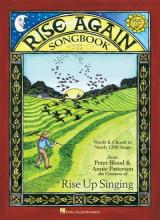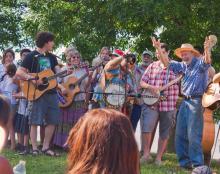Singing Among FGC Friends
Quaker disciplines in the mid-19th century criticized instrumental and choral music as frivolous, "worldly" recreation that led Friends away from God. This viewpoint was abandoned by Hicksite as well as Gurneyite Friends by the beginning of the 20th century. Friends General Conference published a series of hymnals, beginning with a paperback hymnal in 1919 containing 39 hymns. Friends’ first hardback hymnal in 1924 contained 122 hymns. The first version of A Hymnal for Friends was published in 1942, and a revised version was printed in 1955. These hymnals included increasing numbers of hymns that had been rewritten to reflect liberal Quaker theology or attitudes towards Jesus. More recently, singing among FGC Friends has flourished in diverse forms.
Singing was central to the life of Ann Arbor Meeting in Michigan when I grew up there in the ’50s. I’m not sure how often we used to sing together out of the maroon 1955 hymnal (was it every Sunday morning?) but I cannot think of that supportive community of large, young families without fondly remembering hymns, including "For the Beauty of the Earth," "All Things Bright and Beautiful," "This Is My Father’s World," and "At Work Beside His Father’s Bench." Nor can I sing any of those hymns today without recalling vividly the conviction and joy with which we sang them at meeting. Singing those simple lyrics together affirmed who we were as Friends and how we looked at God and God’s world.
My family attended FGC Gatherings in Cape May, New Jersey, several times in the late ’50s and early ’60s. One of my fondest memories of those gatherings is singing hymns in the old convention hall built over the water, and later in the circus tent with the gentle sound of the surf blending with our voices. Many years later I had the great joy of meeting the Friend who probably led many of those sings, Walter Felton, shortly before his death. Walter Felton was able to live long enough to see another hymnal nearly born—though not to see how tremendously successful it would be.
When I was in high school we sang folk songs together, on Saturday nights at the Ann Arbor Meetinghouse and around the campfire at Green Pasture Quarterly Meeting and Lake Erie Yearly Meeting gatherings. We drew heavily on the new "folk revival" songs of Bob Dylan, Joan Baez, and Peter, Paul, and Mary. Later we sang many of these same songs at Young Friends of North America (YFNA) gatherings, New Swarthmoor (a spin-off from YFNA—a fascinating, loose network of individual Friends and communal households trying to practice faithfulness to the Spirit in radical, new ways between 1969 and 1974), events organized in resistance to the Vietnam War, and activities of A Quaker Action Group and its successor, Movement for a New Society (MNS). We ran off informal song-sheets for all of these groups, creating hard-to-read mimeographed collections of the lyrics to a hundred or so Quaker favorites. FGC published two songbooks, May the Long Time Sun and Songs of the Spirit, both of which grew out of mimeographed collections of folk songs and folk hymns. Some of the songs we sang were drawn from the Catholic folk mass movement, such as songs of Joe Wise and the Medical Mission Sisters. The more traditional hymns of the Hymnal for Friends had fallen somewhat out of favor in the groups I sang with at the time.
For years I thought about putting together a more permanent and larger collection of the kinds of songs we included in those songsheet collections. The idea was first born in 1973 at Tamarack Farm, a Quaker workcamp for teenagers located in Vermont. It took six years from that point to create Winds of the People. This was a songbook very similar to our later song collection, Rise Up Singing but funkier—more informal, edited in favor of MNS values, and not very scrupulous with regard to copyright permissions. Most of the song selection and production work were done by Quakers involved in MNS in Philadelphia. David Finke and other MNS Quakers in Chicago printed the book on a tiny press that took months to print the book, two pages at a time.
Singing at Gatherings in the ’80s and ’90sI had not attended an FGC Gathering for many years, but decided to take the newly printed songbook to the Gathering held at Earlham College in 1979. A group of us (I can’t even recall how we found each other) started gathering at the same time each day and singing together using these books. An informal community of singers immediately emerged. Many who sang together that week took a carton of books home with them at the end of the Gathering to use in sing-alongs in their home meetings and communities, and to sell to friends. A kind of underground singing revolution had begun.
The next year an FGC staffer asked us if we would hold these sings at noon to encourage some Friends to eat an hour later and cut down on the long lunch lines right after morning groups. Our numbers swelled gradually until it was not unusual to have 100 or more Friends singing together enthusiastically out of the books. Someone would call out a song name and a chapter, and then everyone would flip to it. Others hauled in guitars and sometimes led songs in place of my wife, Annie Blood-Patterson, and myself.
Various active singers, including Susan Stark, Bobbie Ruby, Ginger Swank, Claire Brandenberg, and Paul Tinkerhess among others, have led singing before evening plenaries over the years. Sometimes we mimeographed songsheets of lyrics (reminiscent of the old days!) so people would have words to sing from. Some years we tried hauling many hundreds of songbooks with us, though that tended to be a bit unwieldy. I recall one particularly moving occasion when a thousand or more Friends gathered at Carlton College joined their voices together joyfully to sing the round "Jubilate" in the college chapel. A Friend wrote me after the Gathering that at that moment she was certain she heard angels, voices joining us from the rafters above.
Singing has flourished at Gatherings in many other settings as well, such as the "torch song" sings led by George Lakey and others around a piano just before or after supper; rounds groups led by Steve Woodbury and others; gospel sings as led by Ginger Swank; shape note sings; and early rock-and-roll singing groups, led by Gretchen Barnett and others. Each of these sings has developed its own mini-communities among gathering attenders, with Friends who look forward to this opportunity to re-form this singing community at subsequent Gatherings.
We also developed a tradition of doing a "farewell sing" around 9 p.m. on Friday night at Gatherings. These frequently drew together 300-400 Friends to say goodbye to a joyful week together via song. In good weather and sufficient light these farewell sings were often held outdoors.
All of these forms of singing combined to mean that singing has come to play an increasingly central role in the Gatherings of recent years. Certainly the old adage that Friends were poor singers has become less and less true!
Rise Up SingingIn the mid-1980s my wife and I decided to try to transform Winds of the People into a fully legitimate songbook. (I should stress that we had tried to get permissions for Winds of the People but had gotten doors slammed in our face virtually without serious consideration of our requests by most of the big music publishers. Many individual artists had given us their permission and we had been scrupulous in not keeping any earnings from Winds.) It had sold over 30,000 copies totally by word of mouth and out of the living rooms of Friends and their friends. It was reborn as Rise Up Singing: bigger, better, fully legal, and thus saleable by bookstores.
The group singing at FGC Gatherings continued. Many meetings began holding monthly sings using one or the other of these songbooks. My wife and I often traveled around to visit meetings and lead sing-along concerts, often cosponsored with other churches, schools or projects that reflected Quaker testimonies. These concerts and ongoing sing-along groups have provided important vehicles for outreach for many meetings. The songbook itself, with its heavy emphasis on Friends testimonies, has been a significant vehicle for promoting our beliefs through the half-million copies sold. We believe, along with folk musician Pete Seeger, that empowered peoples’ singing is an invaluable tool for undermining the grip that a warfare state and consumer culture hold over people’s souls.
Pete SeegerA major highlight occurred at the Gathering held in Harrisonburg, Virginia, in 1997 when Pete Seeger came to sing with us. Friends had tried off and on for many years to get "Pete" (as he is known to many of his fans) to attend a Gathering. Many FGC Friends have been moved and inspired by his musical and political leadership and recognized the major contribution he has made to the movements for peace, social justice, and unity with nature. One such notable effort centered on trying to get Pete and his wife Toshi Seeger to attend a Gathering to be honored by Friends for their great contributions to world peace. Pete hates such events focusing on his own accomplishments and would have nothing of it! Finally, at one point I asked him if there was anything that would get him to attend a Gathering. He said, "Well, I don’t have much energy for singing lots of places anymore. I kind of feel like singing with Friends is singing to the already converted. I like to focus my time as much as I can on singing with new groups who aren’t so familiar with me, like union members, people of color, and young people." My face lit up. I said, "Pete, do you have any idea how many children and teenagers attend these Gatherings?!" Pete was hooked.
Pete brought two African American friends with him to share in his musical contribution to the Gathering. These three led musical workshops for every Junior Gathering group. On Wednesday night a gymnasium was filled with Gathering attenders plus a goodly number of others from Harrisonburg. The entire wall of bleachers along one side of the gym was filled with huge numbers of young people, fully with Pete heart and soul. Pete was very glad to have come.
A New HymnalDespite all of this music making, it took a significant leap of faith for FGC to decide to create a new hymnal. The 1955 hymnal had been out of print for many years and Song of the Spirit had proven inadequate for the needs of Friends, with no great torrent of grassroots demand for a new one. Numerous meetings had stopped singing hymns many years ago, either preferring to sing folk songs using books like Rise Up Singing, or stopping shared singing altogether. A core group of Friends, however, were convinced that the right collection of songs would strike a deep chord among unprogrammed Friends. Certainly, Friends had been singing lustily together at FGC Gatherings every summer. Would the enthusiasm of singing at Gatherings translate into sufficient sales of a new hymnal? Certainly no one could guarantee they would.
Nonetheless, a group was formed to begin the project. I personally stood aside at first in spite of warm invitations to take part. I had a hard time imagining that a committee could create an inspired song collection. I had visions of endless arguments over language, theology, and musical style. Little did I imagine what the Holy Spirit could do with this project!
A selection team was formed (the infamous "Musewog," or Musical Selection Working Group). This team gathered for many long weekends of work, in spite of being scattered across the United States. And the Spirit certainly did guide our work. (I say "our" because I was unable to resist for long the possibility of taking part in such an important musical venture for Friends—I had too much investment in what songs I hoped we would be singing together in years to come.)
All of us, I think, who made up this extraordinary singing community had our own personal convictions about which songs worked and which didn’t, and about how to tackle controversial issues around theology. And yet the Spirit somehow managed to get beyond these personal biases and agendas and to plant conviction in our common hearts as to what songs to include and which (often with great regret) to let go.
The new hymnal, Worship in Song, was finally published in 1996. It has been a rousing success. Certainly there are those who must find it too Christian, too male in its images of God, or who prefer to stick to folkier songs or not to sing at all. Nonetheless, the great quality and diversity of the songs in this collection has appealed to a wide spectrum of Friends. Hymn singing has, as a result, sprung back into the life of many meetings. I predict the hymnal will have as long and successful a contribution to our Quaker movement as the 1955 hymnal.
When my wife and I traveled in New Zealand for six weeks last year, many Friends there were used to referring to Rise Up Singing as "the Quaker hymnal." We took copies of Worship in Song with us and led singing with it at several Quaker gatherings. Friends were not at all used to doing hymn singing in Quaker settings but the hymnal got an enthusiastic response from many Friends. A few at least are now holding hymn sings using Worship in Song at their local meetings.
Singing As Worship?The title of the new hymnal, however, is ironic, since it highlights the enduring ambivalence of unprogrammed Friends towards shared singing during worship. Most Friends enjoy singing and find it spiritually uplifting. I think it is fair to say, however, that many FGC Friends feel very uncomfortable with the idea of group singing as worship. Friends may acknowledge the possibility that an individual Friend may be led by the Spirit to sing a song during meeting for worship—and feel moved and uplifted when this breaks into the life of a meeting. Questions begin to be raised when other Friends join in a song during meeting. And probably most unprogrammed Friends would have real problems with calling out hymn numbers—even spontaneously—during meeting for worship.
Most meetings see singing, whether out of a book like Rise Up Singing or out of a hymnal, as spiritually inspiring and enriching to the bonds that tie the meeting community together, but not as worship per se. There are certainly ways the spiritual content of singing can grow deeper. Annie Blood-Patterson and I have led workshops at the Quaker Center at Ben Lomond, California, and at FGC Gatherings and elsewhere that are composed primarily of worship sharing interwoven with song. A participant "offers up" to the group a song that they feel led to request and the group leaves a period of silence where the requester and others present can share some of the ways the requested song resonates within them and any spiritual reflections that come up for them. As long, however, as we put heavy stock on the idea that vocal ministry needs to spring from direct leading from God during meeting for worship, there is likely to be a certain gulf between group singing as a nurturer of the spirit and vocal ministry during worship in the fullest Quaker sense. This same ambivalence is evident among meetings in Britain, New Zealand, and probably most unprogrammed yearly meetings. This issue was discussed at some length during a recent retreat on the subject of Quakers and music in New Zealand.
In spite of this fact, I believe that the flourishing of group singing has had a major impact on the life of FGC and its meetings during the past century. It has knit our hearts together on First Days in our local meetings, at yearly meetings and national gatherings, in our schools and camps, and on the picket line or at organizing meetings. Song has played an important role in a number of the social movements that Friends have been involved in, especially the union, freedom, and peace movements. Song will continue to transform Friends hearts and fill us with hope and the energy to take on the forces of evil around us for many generations to come.
(Peter Blood-Patterson teaches Bible and Quakerism at Westtown School. He and his wife Anne have traveled extensively in the ministry under a concern for the movement of the spirit through music under minutes from Middletown Meeting in Lima, Pennsylvania. © 2002 Peter Blood)





